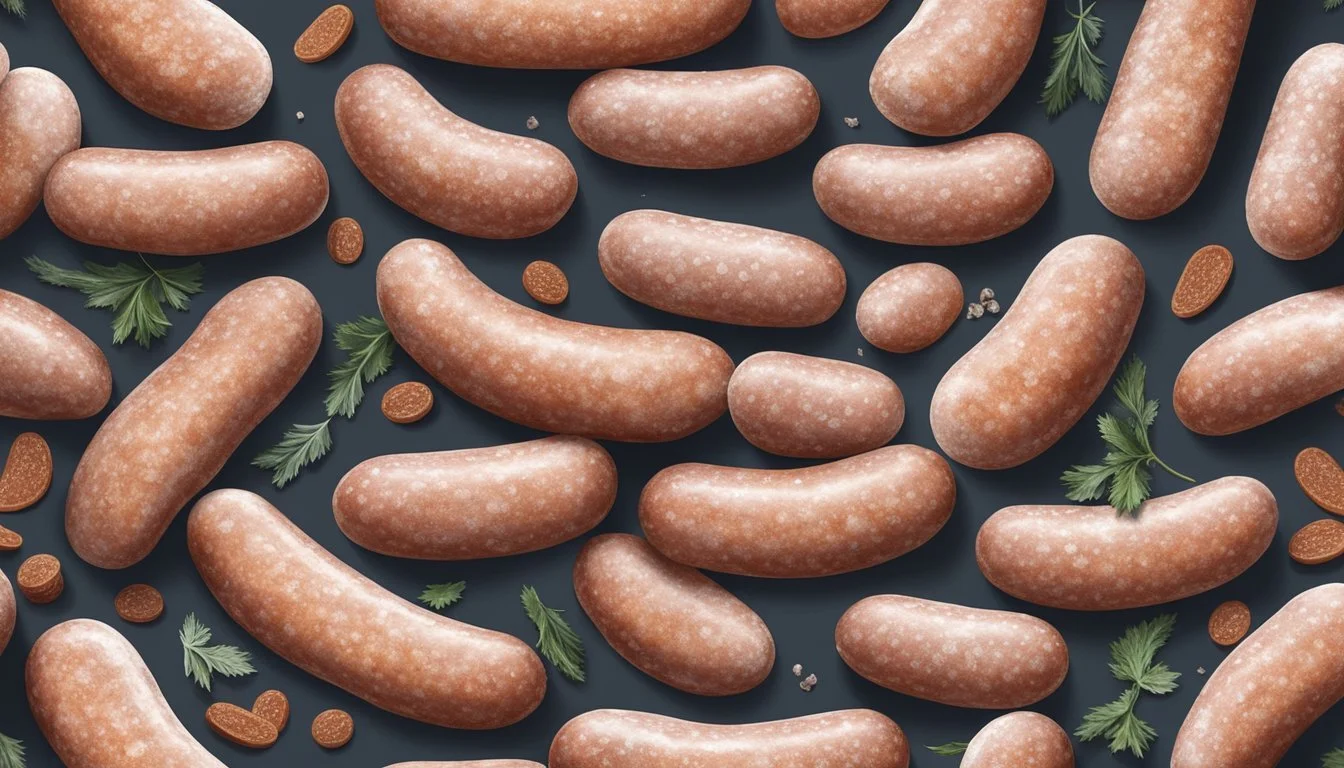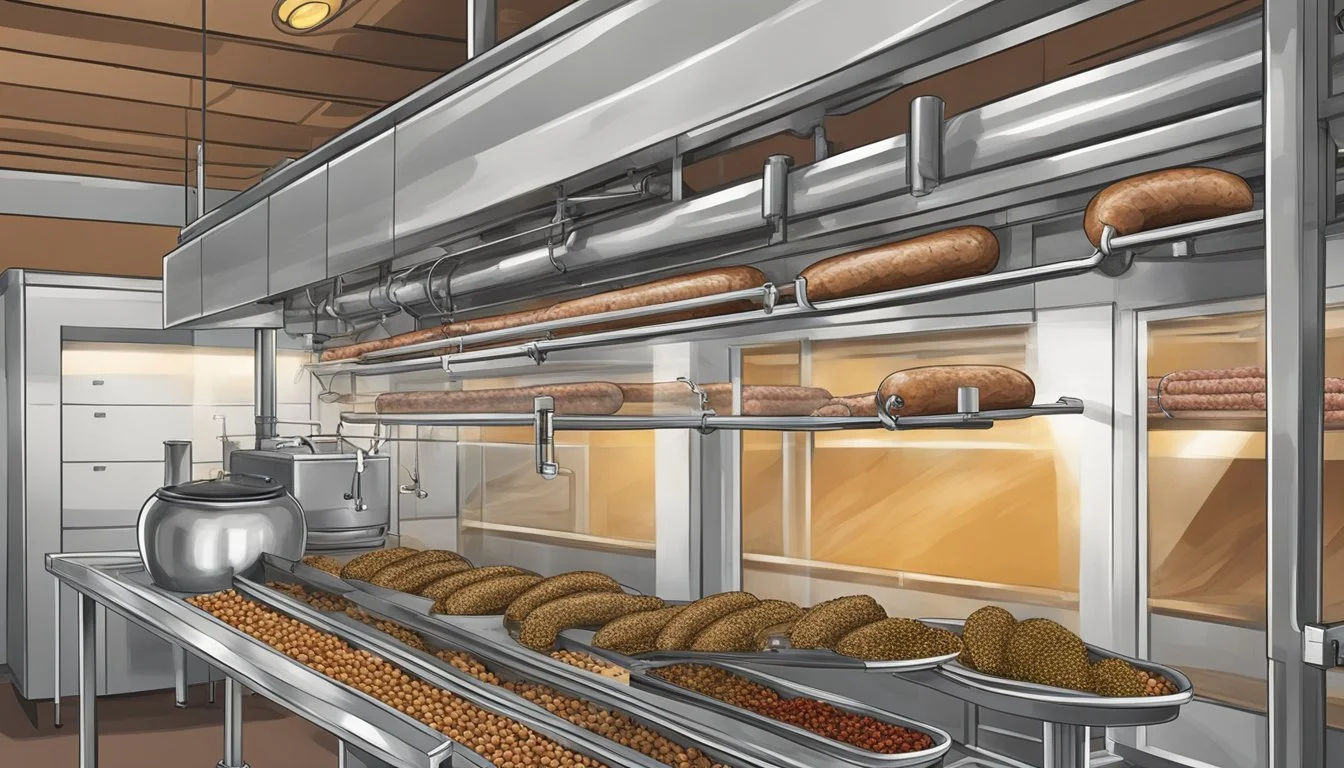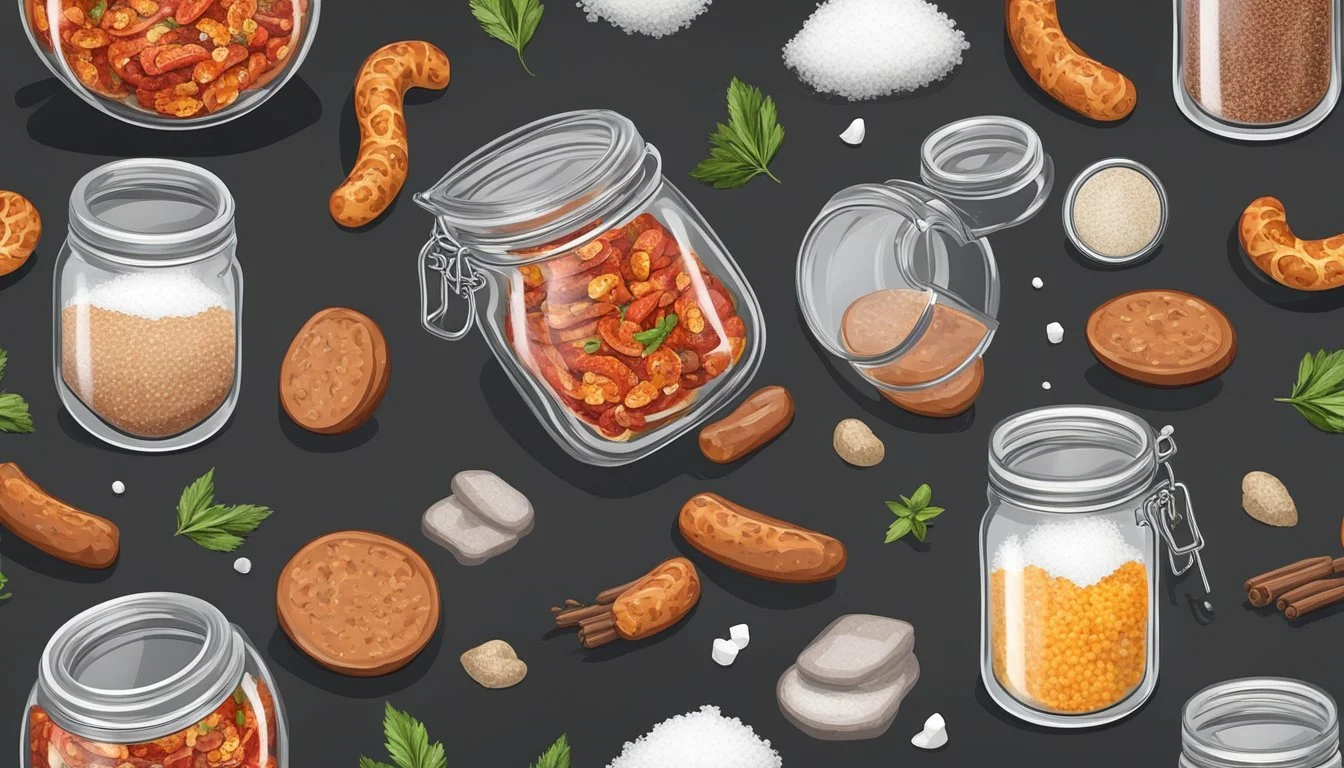How to Ferment Pepperoni
Your Guide to Homemade Fermented Sausage
Pepperoni, a type of fermented sausage, is a culinary favorite known for its bold flavor and versatility. The process of fermenting pepperoni involves curing meat through controlled microbial growth and enzymatic reactions, which result in a distinctive tangy taste and preserved state. This is achieved by combining ground pork with an array of spices, such as paprika and cayenne pepper, along with salt, sugar, and a starter culture of beneficial bacteria. The mixture is then encased and subjected to specific conditions of temperature and humidity to commence the fermentation process.
Fermentation is a critical step in the production of pepperoni, where the sausage is kept at a stable warmth and humidity level conducive to the growth of the starter culture. This stage is crucial as it directly influences the flavor, texture, and safety of the final product. During this stage, the pH of the meat drops, which decreases the risk of pathogenic bacteria and prepares the pepperoni for further smoking or drying. After fermentation, some recipes may call for the pepperoni to be smoked, adding another layer of flavor depth, before it is moved to a drying chamber where the sausage is cured to perfection.
Understanding Fermented Sausages
Fermented sausages, such as pepperoni, are renowned for their complex flavors and unique textures derived from processes of fermentation and drying.
History and Significance
For centuries, the art of making fermented sausages has been a treasured culinary practice. Originating from different regions, each variety, like the spicy chorizo from Spain or tangy salami from Italy, showcases a rich heritage of flavor mastery. These sausages are not simply food but represent a historical connection to the innovation and regional identity of various cultures.
Basic Concepts of Fermentation and Drying
Fermentation is the heart of creating a fermented sausage. It involves beneficial bacteria consuming sugars and producing lactic acid, resulting in a lower pH level. This acidity is crucial for the development of both the signature tangy flavor and the safety of the sausage by inhibiting harmful bacteria growth.
Dry Sausages: Featuring a pH typically between 5.0 and 5.3, they undergo a significant pH drop early in the aging process, which gradually recalibrates over time, enhancing flavor.
Semi-dry Sausages: Characterized by a slightly different texture and moisture content compared to dry sausages, with a higher pH level on average.
The drying phase follows fermentation, where sausages are left to mature, reducing moisture content. This drying concentrates the flavors and creates the characteristic firm texture of fermented sausages. Both temperature and humidity are meticulously controlled during drying to ensure safety and quality of the final product.
Selecting Ingredients for Pepperoni
The quality of pepperoni is largely determined by the selection of meats, spices, curing agents, and bacteria cultures used during the fermentation process. Each ingredient plays a critical role in developing the unique flavor profile and ensuring safety throughout the curing period.
Choosing the Right Meat
Meat is the primary component of pepperoni. A combination of pork and beef is typically used to balance flavor and texture. Pork butt, known for its ideal fat-to-protein ratio, is favored for its tenderness and moisture retention. Beef chuck complements this by adding a robust flavor and firm texture. It is important to select fresh, high-quality cuts to ensure the best outcome.
Spices and Flavorings
The distinctive taste of pepperoni comes from a carefully measured blend of spices and other flavorings. Essential spices include paprika for sweetness and color, garlic (What wine goes well with garlic?) for pungency, and cayenne pepper for heat. These are combined in precise proportions to create a consistent and desired flavor profile. The addition of dextrose provides a source of sugar necessary for the growth of beneficial bacteria during fermentation.
Curing Agents and Bacteria Cultures
Curing agents are vital for both flavor development and food safety. Prague Powder #2, a specific type of cure containing sodium nitrate and sodium nitrite, is commonly used in pepperoni to prevent spoilage and the growth of harmful bacteria. For fermentation, selecting the right starter culture is crucial. This often consists of Lactobacillus and Pediococcus bacteria which lower the pH through lactic acid production, aiding in flavor development and preservation. Ascorbic acid may also be added to accelerate the curing process.
Preparing the Pepperoni Mixture
The mixture preparation is a critical step in making pepperoni, involving precise meat grinding, careful blending of spices and curing agents, and the incorporation of a starter culture essential for fermentation.
Meat Grinding Techniques
For optimal texture in pepperoni, the meat should be ground to the appropriate coarseness using a meat grinder. Most recipes call for a fine grind to ensure a compact sausage after stuffing. It is important to keep both the meat and the equipment chilled to prevent fat smearing, which can negatively affect the texture of the pepperoni.
Chill the meat before grinding: below 32°F (0°C).
Use a fine grinding plate: 3/16 to 1/4 inch (4.5 to 6 mm).
Blending Spices and Curing Agents
After grinding, blend the spices and curing agents thoroughly with the meat. A well-mixed blend ensures an even distribution of flavors throughout the pepperoni.
Ingredient: Salt
Purpose: Flavor and preservation
Ingredient: Sugar
Purpose: Balances salt, aids fermentation
Ingredient: Garlic powder
Purpose: Flavor
Ingredient: Paprika
Purpose: Flavor and color
Ingredient: Cayenne pepper
Purpose: Adds heat
Ingredient: Curing Salt (e.g., Prague Powder #1 or #2)
Purpose: Ensures safety during fermentation
Ensure all spices and curing salt are mixed evenly before proceeding.
Use precise measurements for safety and flavor consistency.
Incorporating the Starter Culture
The starter culture initiates the fermentation process, which is essential for developing the characteristic tangy flavor and for ensuring safety. The culture should be well-distributed throughout the meat mixture.
Mix the starter culture into the spice and meat blend thoroughly.
Handle the culture according to the manufacturer's recommendations for temperature and quantity.
By adhering to these techniques, one can create a high-quality pepperoni mixture that is ready for fermentation, encapsulating the robust flavors and setting the stage for a successful dry-curing process.
Stuffing and Curing the Sausage
Before one begins the fermentation process of making pepperoni, careful attention must be given to correctly stuffing the casings and then guiding the sausage through the distinct stages of fermentation and curing, where temperature and humidity play crucial roles.
Filling the Casings
To ensure proper fermentation and curing, one should diligently fill the casings to avoid air pockets, which can impede the process. Pepperoni is usually encased in sausage casings made of beef or sometimes synthetic materials. A sausage stuffer is typically used for this purpose, ensuring even distribution of the meat mixture. The casings should be filled firmly, which helps in forming the sausage shape and size consistently.
Fermentation and Curing Stages
Following stuffing, the sausage undergo natural fermentation and curing stages. Here, bacteria play a pivotal role in reducing the sausage's pH through the consumption of sugars, producing acid as a byproduct. The fermentation process usually occurs at temperatures between 80°F and 90°F, with optimal humidity levels set around 85-90%. This environment is maintained for a duration of 18-24 hours to allow the pH to drop to a target range, commonly between 4.6 and 5.0.
Fermentation Criteria: Temperature
Target Range: 80°F - 90°F
Fermentation Criteria: Humidity
Target Range: 85-90%
Fermentation Criteria: pH Level
Target Range: 4.6 - 5.0
Once fermented, the curing phase begins, which may involve a slow increase in temperature while carefully monitoring the internal temperature of the individual sausages to assure they reach the safe zone of 140°F. Curing solidifies the pepperoni's flavor and sets the stage for additional drying, if desirable, for a firmer texture.
Drying and Aging Process
The drying and aging stage is critical for developing the pepperoni's flavor and safe consumption. This process involves a balance of humidity and temperature to cure the sausage without compromising its quality.
Controlling Humidity and Temperature
To begin drying, the sausage needs to be placed in a drying chamber. This controlled environment should have:
Relative Humidity (RH): 85-90% for the first 24 hours, then gradually decreased to 75% over the following days.
Temperature: Start at 86°F (30°C), then slowly lower to around 55-60°F (13-15°C) for the remainder of the aging process.
It is important to note that a consistent, controlled environment prevents the formation of undesirable air pockets and ensures a uniform drying throughout the pepperoni.
Monitoring and Adjusting the Process
They must regularly monitor the internal temperature of the sausage, ensuring it reaches 140°F (60°C) to be fully cured. Observing the reduction of the relative humidity is also crucial; if the chamber becomes too dry or too humid, adjustments should be made to maintain an optimal environment for the aging process. The presence of sugar in the recipe is essential for this phase, as it provides food for the beneficial bacteria that facilitate proper fermentation and drying.
Quality Assurance and Storage
Ensuring the safety and longevity of fermented sausage like pepperoni involves diligent practices in detecting and preventing issues as well as employing the right long-term storage techniques. These measures are critical to preserving the flavor, preventing the growth of pathogenic bacteria, and extending shelf life.
Detecting and Preventing Issues
To detect and prevent issues in homemade pepperoni, one must maintain strict sanitation throughout the fermentation and curing processes. Controlled fermentation is key to preventing the growth of unwanted bacteria. This includes:
Temperature Monitoring: Maintaining a consistent fermentation temperature, typically around 86°F (30°C), to ensure the development of lactic acid bacteria that inhibit pathogens.
pH Testing: Regularly testing that the sausage pH stays below 5.3, which is essential for safety and quality.
Closely monitoring the appearance and smell of the pepperoni, as any off odors or unusual mold may indicate contamination.
Long-Term Storage Practices
Once the pepperoni is cured, proper storage is essential to extending its shelf life and maintaining quality. The best storage practices include:
Refrigeration: Storing pepperoni in the refrigerator at temperatures below 40°F (4°C) slows microbial growth.
Tip: Wrap the pepperoni in butcher paper or vacuum-seal it to protect against air and moisture.
Airtight Containers: Utilizing airtight containers for storage can significantly extend the shelf life while keeping the pepperoni safe from contaminants.
Handling pepperoni carefully and ensuring it is stored in the correct conditions not only extends its shelf life but also assures that the quality and taste of the homemade pepperoni remain intact.
Serving and Culinary Uses
Fermented pepperoni is a versatile ingredient recognised for enhancing a variety of dishes with its rich, spicy flavors. It is commonly used as a pizza topping and in sandwiches, offering a distinct taste that complements various ingredients.
Pepperoni in Dishes
Fermented pepperoni is best known for its role on top of pizzas. The high fat content allows it to cook evenly, releasing flavors into the pizza as it crisps in the oven. Beyond pizzas, pepperoni can be sliced into thin rounds and incorporated into pasta dishes, baked into bread, or diced to add a spicy kick to salads. The robust flavor of pepperoni also stands out in sandwiches, particularly when paired with Italian cheeses and a drizzle of mustard.
Pizza: As a topping, pepperoni provides a spicy and savory counterpoint to the dough and cheese.
Pasta: Chopped pepperoni adds depth to tomato sauces and provides a flavor contrast in cream-based sauces.
Bread: Diced pepperoni can be folded into bread dough for a spicy twist.
Salads: Thinly sliced pepperoni contributes both texture and flavor to fresh salads.
Pairing with Other Foods
Pepperoni pairs well with a range of other foods, from cheeses to fruits. A classic charcuterie (What wine goes well with charcuterie?) board often features pepperoni alongside a selection of cheese such as mozzarella, provolone, or cheddar, which matches its boldness without overshadowing its distinctive taste. When it comes to fruits, pepperoni's spiciness is complemented by the sweetness of fruits like pineapple or figs. A pepperoni and cheese sandwich with a hint of mustard adds complexity and pungency, balancing the pepperoni's richness.
Cheeses: Mozzarella, provolone, and cheddar are excellent companions for pepperoni.
Fruits: Sweet fruits like pineapple or figs offer a pleasant contrast to the meat's spiciness.
Mustard: A condiment that provides a tangy flavor which complements the bold taste of pepperoni in sandwiches.
Health Considerations and Nutritional Value
When considering fermented pepperoni, it's important to understand its health impact and nutritional composition. Fermented sausages like pepperoni can offer benefits associated with fermented foods, (What wine goes well with fermented foods?) but consumers should be mindful of the fat and salt content.
Benefits of Fermented Foods
Fermented foods, including pepperoni, are associated with improved gut health due to the presence of probiotics—beneficial bacteria that can aid digestion. These microorganisms contribute to a balanced gut microbiota. As the fermentation process occurs, it potentially enhances the bioavailability of nutrients and can generate new nutrients or bioactive compounds that contribute to overall health. Research indicates that adding fiber to fermented sausages can have prebiotic effects, supporting the growth of healthy gut bacteria during the fermentation process.
Understanding the Fat and Salt Content
One cannot ignore the nutritional aspects of fat and salt content in fermented sausages:
Fat: Fermented sausages like pepperoni typically contain a considerable amount of fat, which is a key component in their flavor and texture. However, it's essential to consume fat in moderation, as excessive intake can lead to health issues.
Salt: Salt is a critical ingredient in the preservation and fermentation process, aiding in flavor development and food safety by inhibiting the growth of unwanted microorganisms. Yet, high salt intake is a concern for blood pressure and cardiovascular health.
Consumers interested in the nutritional benefits of fermented foods like pepperoni should balance their intake, considering the fat and salt content against the potential health benefits.
Advanced Techniques and Variations
In the pursuit of crafting the perfect pepperoni, enthusiasts often explore advanced techniques and introduce variations to traditional recipes. These methods can dramatically alter the flavor, texture, and overall quality of the finished product.
Experimenting with Different Meats and Spices
While pepperoni is traditionally made with a blend of pork and beef, one can experiment with other meats such as venison or turkey to alter the flavor profile. Spices, too, play a critical role; for instance, aniseed adds a distinctive licorice note, while dried garlic granules can intensify the umami character of the sausage.
Meat Variations:
Pork and Beef: The classic combination.
Venison: Gamey and lean, which may result in a drier texture.
Turkey: Lighter and may require additional fats to maintain moisture.
Spice Blends:
Classic Pepperoni: Paprika, cayenne, and garlic.
Aniseed: Offers a sweet, licorice-like flavor.
Garlic: Robust and aromatic using granules for consistency.
Creating Unique Flavors and Textures
The fermentation process is where the magic happens, yielding the tangy flavor and firm texture pepperoni is known for. For those aiming to craft a bespoke product, incorporating red wine can contribute both to the depth of flavor and as a tenderizer. Regarding texture, the choice of casing can be crucial; opting for mini salami casing will affect the drying time and result in a different mouthfeel compared to traditional casings.
Flavor Enhancements:
Red Wine: Adds complexity and assists in tenderization.
Cold Smoke: Imbues a subtle, smoky taste without cooking the meat.
Texture Modifications:
Drying: Longer drying will result in a firmer, chewier texture.
Casing Choice: Smaller casings like those used for mini salami make for quicker drying and can influence the fermentation process.
By implementing these techniques, makers of fermented sausages such as summer sausage, salami, and kielbasa, alongside varieties like smoked salamis, can push the boundaries to produce distinctive, high-quality cured meats (What wine goes well with cured meats?).
DIY Tips and Common Mistakes
When fermenting pepperoni at home, it's essential to adhere to processing steps meticulously and select the appropriate meat. One must rely on a trusted recipe to ensure safety and quality. Improper technique can lead to poor taste and texture, or even foodborne illness.
Home Processing Steps
Meat Selection:
Choose high-quality pork, with a fat content around 20% to 30% for optimal flavor and texture.
Preparation:
Weigh all ingredients precisely.
Maintain a clean working environment to prevent contamination.
Mixing:
Combine meat with seasonings evenly.
Incorporate the starter culture accurately to facilitate proper fermentation.
Stuffing:
Stuff the casing evenly, avoiding air pockets which can cause spoilage.
Use beef middles or high-quality synthetic casings approximately 60 mm in diameter.
Fermentation:
Ferment at 86°F (30°C) and 85-90% humidity for 24 hours.
Smoking:
Smoke at 110°F - 130°F and 70% humidity for about 6 hours.
Drying:
Cure in a controlled environment until the desired dryness is achieved.
Troubleshooting and Solutions
Texture Issues:
Problem: Sausage is too dry or too moist.
Solution: Check that the meat-to-fat ratio is correct; adjust humidity and drying time.
Flavor Problems:
Problem: Flavor is bland or too acidic.
Solution: Ensure accurate seasoning and starter culture measurement; verify fermentation conditions.
Discoloration:
Problem: The sausage has dark or greenish spots.
Solution: Eliminate air pockets during stuffing; maintain consistent smoking conditions.
Spoilage:
Problem: Presence of mold or off smell.
Solution: Clean equipment thoroughly; ensure appropriate fermentation and drying environment.
Casing Issues:
Problem: Casing is tough or doesn’t peel easily.
Solution: Use high-quality casings and take care not to overstuff or understuff.
These guidelines are crucial for both safety and optimal taste. Each step in the process needs attention, and problems should be addressed quickly with suggested solutions.
Resources and Further Reading
To ferment pepperoni successfully, one requires a combination of reliable resources for in-depth knowledge and a community-driven support system. Below are curated subtopics offering concrete literature and dynamic online platforms to assist enthusiasts and professionals in the art of sausage making.
Books and Guides on Sausage Making
Books:
Charcuterie: The Craft of Salting, Smoking, and Curing by Michael Ruhlman and Brian Polcyn: This comprehensive guide offers detailed instructions on fermenting sausages, including pepperoni, and helps readers understand the role of smokers and meat grinders.
Home Production of Quality Meats and Sausages by Stanley and Adam Marianski: They delve into the principles of sausage making, including equipment like grinders and sausage stuffers.
Guides:
Sausage Maker's Catalogs: Often include detailed guides on using equipment such as meat grinders and sausage stuffers.
Manufacturer Guides: Equipment manufacturers like smoker and smokehouse brands often provide resources to get the best out of their products.
Online Communities and Forums
Forums:
Sausage Making Forums: These platforms offer a wealth of information where members share experiences, troubleshoot issues with fermenting sausages, and discuss the practical use of sausage stuffers and smokers.
Smokehouse Forums: For those keen on using a smoker for pepperoni, these forums can provide specific advice and smokehouse techniques.
Large Websites:
Meat Processing Websites: Provide tutorials and articles which often cover fermentation principles, including the role of yeast in the fermentation process.
Culinary Websites: May offer recipe exchanges centered around fermented sausage making, along with insights on equipment like grinders and smokers.
By engaging with the above resources, readers can enhance their understanding of fermenting pepperoni through expert literature and communal knowledge sharing. The combination of academic resources and active forums presents a solid foundation for perfecting the craft of sausage fermentation.










